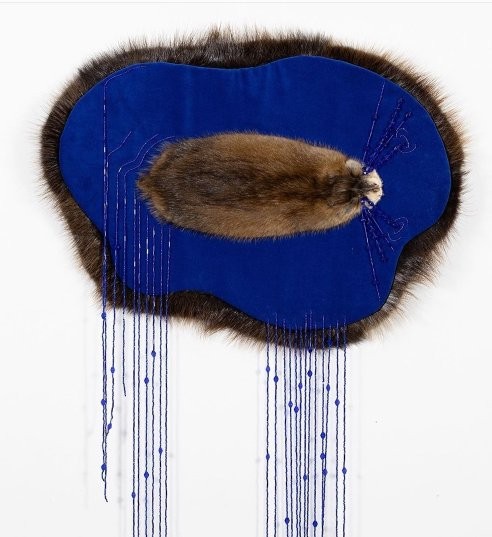
Depression can be difficult to talk about, even though it has touched the lives of so many. Métisartist Marcy Friesen is creating artwork that will start that conversation. “I don’t remember a time when I wasn’t concerned about somebody that had a mental health issue or was suffering from depression. For a time, myself, I had gone through depression. Thankfully I came out of it with the help of medication,” she says. “It’s still a taboo subject, even though people are saying it’s getting better. It still feels so shameful to talk about it. If you have struggles with mental health, you can feel weak. It’s just a lot easier if it’s something that can be talked about.”
With the help of a Micro-Grant, Friesen is beading an oversized “Depression Moccasin” in various shapes and shades of blue beads to represent the tears shed by someone living with depression, as well as the struggles of their caregivers. “It affects more than one person. It affects a whole community of people.”
The outside of the moccasin represents the caregiver, and the inside sole represents someone living with depression. Friesen is beading in circular patterns to show the feeling of “being stuck” and using raised beadwork to illustrate feeling out of control. The top of the inside of the moccasin is lined with a blanket, representing someone who is tired and unable to get out of bed. The outer sole is a beaver hide, which leaves a soft footprint. “This represents that no one knows where you have been or what you have gone through in your life,” she explains. A horsehair braid finishes the piece, binding the sole to the moccasin and reinforcing the role of the caregiver. The moccasin stands alone rather than as a pair, to echo feelings of isolation.
The project is not without its challenges. Friesen lives near Carrot River in northeast Saskatchewan. There are no stores nearby that sell supplies, so she has to purchase beads online or travel two hours to a bead store with limited supplies. But there are advantages to working as an artist in a rural area. “I live out on the farm with my family. It’s quiet, so I can take the time that I need. Even if it’s going for a walk to clear my head and think about a project – there’s no one around. I’m always thinking about my projects; my mind is going nonstop,” she says.
 Until recently Friesen has focused on wearable artwork, such as gauntlets, mitts, fur hats, moccasins and jewelry. She now wants to focus on creating contemporary art with traditional materials. “My goal is to have my art in galleries and not only in the gallery gift stores,” she says. “It’s totally different when there’s a meaning behind it, rather than whipping up a pair of moccasins to please someone and make money. I want to move beyond that.”
Until recently Friesen has focused on wearable artwork, such as gauntlets, mitts, fur hats, moccasins and jewelry. She now wants to focus on creating contemporary art with traditional materials. “My goal is to have my art in galleries and not only in the gallery gift stores,” she says. “It’s totally different when there’s a meaning behind it, rather than whipping up a pair of moccasins to please someone and make money. I want to move beyond that.”
To advance her practice, Friesen has been paired with experienced beader, Ruth Cuthand, through the CARFAC Saskatchewan mentorship program. “She saw that I really wanted to learn, but I didn’t have anyone to learn from and grow,” Friesen says. “My mom and family members loved everything I made, but I needed constructive criticism. I find it interesting now to learn to use my beads in different ways and styles and not only make moccasins and gauntlets but use what I can do in a more contemporary art form.”
Friesen plans to finish the Depression Moccasin in May and hopes to submit the piece to galleries for consideration for exhibitions. “I hope when people look at it and see how it is made, they will ask questions about it and its purpose. I hope it opens up discussion and proposes solutions for the depression and suicide crisis.”
Photos:
Top: Marcy Friesen. Photo by Tianna Marie Photography
Bottom: Marcy Friesen, Muskrat Tears, 2020, velveteen, glass beads, plastic seed beads, bugle beads, muskrat and beaver pelt. Photo:@therealmikepatten
